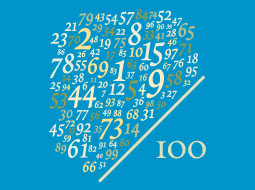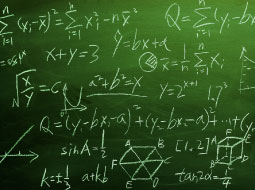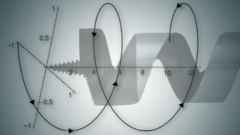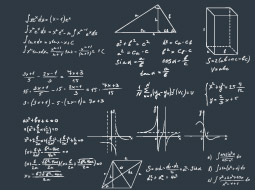Online courses directory (418)
This course covers the mathematical techniques necessary for understanding of materials science and engineering topics such as energetics, materials structure and symmetry, materials response to applied fields, mechanics and physics of solids and soft materials. The class uses examples from the materials science and engineering core courses (3.012 and 3.014) to introduce mathematical concepts and materials-related problem solving skills. Topics include linear algebra and orthonormal basis, eigenvalues and eigenvectors, quadratic forms, tensor operations, symmetry operations, calculus of several variables, introduction to complex analysis, ordinary and partial differential equations, theory of distributions, and fourier analysis.
Users may find additional or updated materials at Professor Carter's 3.016 course Web site.
This class introduces elementary programming concepts including variable types, data structures, and flow control. After an introduction to linear algebra and probability, it covers numerical methods relevant to mechanical engineering, including approximation (interpolation, least squares and statistical regression), integration, solution of linear and nonlinear equations, ordinary differential equations, and deterministic and probabilistic approaches. Examples are drawn from mechanical engineering disciplines, in particular from robotics, dynamics, and structural analysis. Assignments require MATLAB® programming.
Numerical methods for solving problems arising in heat and mass transfer, fluid mechanics, chemical reaction engineering, and molecular simulation. Topics: numerical linear algebra, solution of nonlinear algebraic equations and ordinary differential equations, solution of partial differential equations (e.g. Navier-Stokes), numerical methods in molecular simulation (dynamics, geometry optimization). All methods are presented within the context of chemical engineering problems. Familiarity with structured programming is assumed. The examples will use MATLAB®.
Acknowledgements
The instructor would like to thank Robert Ashcraft, Sandeep Sharma, David Weingeist, and Nikolay Zaborenko for their work in preparing materials for this course site.
This beginners math course is an ideal introduction to fractions. The tutorial uses an interactive multimedia format and relevant examples to thoroughly examine the topic. It is ideal as a study aid or as a complement to face-to-face classes.
In this course on the mathematics of infinite random matrices, students will learn about the tools such as the Stieltjes transform and Free Probability used to characterize infinite random matrices.
Statistics is about extracting meaning from data. In this class, we will introduce techniques for visualizing relationships in data and systematic techniques for understanding the relationships using mathematics.
This course provides a brisk, challenging, and dynamic treatment of differential and integral calculus, with an emphasis on conceptual understanding and applications to the engineering, physical, and social sciences.
This free online course in Pre-Algebra mathematics for high school students will guide you through several different areas of mathematics such as integers, one-step equations, inequalities and equations, graphs and functions, percent, probabilities. There is also an introduction into geometry and right triangles. The course is divided into twelve modules and each module is divided into several lessons. Under each lesson you will find theory, examples and video lessons. This course is ideal for learners who want to gain a comprehensive knowledge and understanding of topics in pre-algebra which they can build on in later courses.
In this undergraduate level seminar series, topics vary from year to year. Students present and discuss the subject matter, and are provided with instruction and practice in written and oral communication. Some experience with proofs required. The topic for fall 2008: Computational algebra and algebraic geometry.
This course forms an introduction to a selection of mathematical topics that are not covered in traditional mechanical engineering curricula, such as differential geometry, integral geometry, discrete computational geometry, graph theory, optimization techniques, calculus of variations and linear algebra. The topics covered in any particular year depend on the interest of the students and instructor. Emphasis is on basic ideas and on applications in mechanical engineering. This year, the subject focuses on selected topics from linear algebra and the calculus of variations. It is aimed mainly (but not exclusively) at students aiming to study mechanics (solid mechanics, fluid mechanics, energy methods etc.), and the course introduces some of the mathematical tools used in these subjects. Applications are related primarily (but not exclusively) to the microstructures of crystalline solids.
This course is divided into two sections, Part I and Part II. Part I, found here, provides an introduction to statistical theory. A brief review of probability will be given mainly as background material, however, it is assumed to be known. Topics include normal distribution, limit theorems, Bayesian concepts, and testing, among others.
Part II prepares students for the remainder of the econometrics sequence and and can be found by visiting 14.381 Fall 2006.
Identifying types of quadrilaterals, finding measurements, and applying and proving postulates. Quadrilateral Overview. Quadrilateral Properties. Area of a Parallelogram. Area of a Regular Hexagon. Sum of Interior Angles of a Polygon. Sum of the exterior angles of convex polygon. Proof - Opposite Angles of Parallelogram Congruent. Proof - Opposite Sides of Parallelogram Congruent. Proof - Diagonals of a Parallelogram Bisect Each Other. Rhombus Diagonals. Proof - Rhombus Diagonals are Perpendicular Bisectors. Proof - Rhombus Area Half Product of Diagonal Length. Area of a Parallelogram. Area of a Regular Hexagon. Problem involving angle derived from square and circle. 2003 AIME II Problem 7. CA Geometry: Deducing Angle Measures.
Calculus One is a first introduction to differential and integral calculus, emphasizing engaging examples from everyday life.
This course teaches a calculus that enables precise quantitative predictions of large combinatorial structures.
The math behind human, animal and machine communication. What is Information Theory?. Prehistory: Proto-writing. Ptolemaic: Rosetta Stone. Ancient History: The Alphabet. Source Encoding. Visual Telegraphs (case study).
20th century solutions to new problems in Cryptography. The Fundamental Theorem of Arithmetic. Public Key Cryptography: what is it?. The Discrete Logarithm Problem. Diffie-Hellman Key Exchange. RSA Encryption: step 1. RSA Encryption: step 2. RSA Encryption: step 3. Euler's Totient Function. RSA Encryption: step 4. What should we learn next?.
Videos on trigonometry. Watch the "Geometry" playlist first if you have trouble understanding the topics covered here. Basic Trigonometry. Basic Trigonometry II. Radians and degrees. Using Trig Functions. Using Trig Functions Part II. The unit circle definition of trigonometric function. Unit Circle Definition of Trig Functions. Graph of the sine function. Graphs of trig functions. Graphing trig functions. More trig graphs. Determining the equation of a trigonometric function. Trigonometric Identities. Proof: sin(a+b) = (cos a)(sin b) + (sin a)(cos b). Proof: cos(a+b) = (cos a)(cos b)-(sin a)(sin b). Trig identities part 2 (parr 4 if you watch the proofs). Trig identies part 3 (part 5 if you watch the proofs). Trigonometry word problems (part 1). Trigonometry word problems (part 2). Law of cosines. Navigation Word Problem. Proof: Law of Sines. Ferris Wheel Trig Problem. Ferris Wheel Trig Problem (part 2). Fun Trig Problem. Polar Coordinates 1. Polar Coordinates 2. Polar Coordinates 3. Inverse Trig Functions: Arcsin. Inverse Trig Functions: Arctan. Inverse Trig Functions: Arccos. Trigonometry Identity Review/Fun. Tau versus Pi. IIT JEE Trigonometry Problem 1. IIT JEE Trigonometric Maximum. IIT JEE Trigonometric Constraints. Trigonometric System Example. 2003 AIME II Problem 11.avi. 2003 AIME II Problem 14.
Topics in surface modeling: b-splines, non-uniform rational b-splines, physically based deformable surfaces, sweeps and generalized cylinders, offsets, blending and filleting surfaces. Non-linear solvers and intersection problems. Solid modeling: constructive solid geometry, boundary representation, non-manifold and mixed-dimension boundary representation models, octrees. Robustness of geometric computations. Interval methods. Finite and boundary element discretization methods for continuum mechanics problems. Scientific visualization. Variational geometry. Tolerances. Inspection methods. Feature representation and recognition. Shape interrogation for design, analysis, and manufacturing. Involves analytical and programming assignments.
This course was originally offered in Course 13 (Department of Ocean Engineering) as 13.472J. In 2005, ocean engineering subjects became part of Course 2 (Department of Mechanical Engineering), and this course was renumbered 2.158J.
This free online course in Geometry is for high school and secondary school students. The course will guide you through several different areas of Geometry such as points, lines, angles, triangles, quadrilaterals and circles, as well as transformations and area. The course is divided into ten modules and each module is divided into several lessons. Under each lesson you will find theory, examples and video lessons. This course is ideal for learners who want to gain a comprehensive knowledge and understanding of topics in Geometry which they can build on in later courses.
Geometry and Quantum Field Theory, designed for mathematicians, is a rigorous introduction to perturbative quantum field theory, using the language of functional integrals. It covers the basics of classical field theory, free quantum theories and Feynman diagrams. The goal is to discuss, using mathematical language, a number of basic notions and results of QFT that are necessary to understand talks and papers in QFT and String Theory.
Trusted paper writing service WriteMyPaper.Today will write the papers of any difficulty.




















